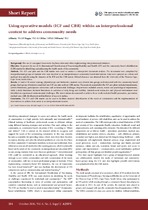Using operative models (ICF and CBR) within an interprofessional context to address community needs : short report - Interprofessional education, practice and research supplement

View/
Date
2016Author
Rhoda, Anthea
Waggie, Firdouza
Filies, Gerard C.
Frantz, Jose M.
Metadata
Show full item recordAbstract
BACKGROUND: The use of conceptual frameworks has been advocated when implementing interprofessional initiatives.
OBJECTIVE: To present the use of the International Classification of Functioning Disability and Health (ICF) and the community-based rehabilitation
(CBR) matrix for identifying and addressing the health needs of the community.
METHODS: The ICF care plan and the CBR matrix were used to conduct a retrospective document analysis. The documents were completed by
interprofessional groups of students who were involved in an interprofessional community-based intervention. Data were captured on a sheet and
analysed descriptively using the domains of the ICF and the CBR matrix. Ethical clearance was obtained from the University of the Western Cape,
Cape Town, South Africa.
RESULTS: A total of 30 senior nursing, physiotherapy and biokinetics students were divided into groups and interacted with five community-based
groups. Each group of students completed one ICF care plan and one CBR matrix. The needs documented in the ICF care plans included impairments,
activity limitations, participation restrictions and environmental challenges. Impairments included sensory, motor and psychological impairments,
while activity limitations included limitations in activities of daily living and mobility. Limited social interaction and physical environment were
identified as experienced environmental challenges. The interventions documented to address these needs included health promotion, prevention,
medical care, skills development and facilitation of access to justice.
CONCLUSION: The ICF and CBR matrix can be used to facilitate students' identification of the needs of communities and the implementation of
interventions to address these needs in an interprofessional manner.
